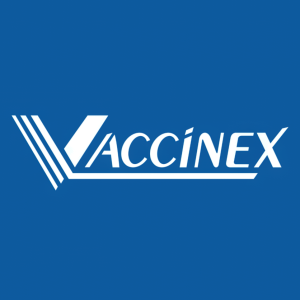Vaccinex to Report Promising New Clinical Data Revealing Pepinemab’s Unique Mechanism to Enhance Immunotherapy at Annual Meeting of American Association for Cancer Research (AACR)
Rhea-AI Summary
Vaccinex (NASDAQ: VCNX) announced new clinical data demonstrating pepinemab's mechanism in enhancing immunotherapy effectiveness, to be presented at the 2025 AACR Annual Meeting in Chicago on April 29, 2025.
The data reveals that pepinemab, a Semaphorin 4D blocking immunotherapy, induces mature lymphoid structures (TLS) that correlate with durable clinical benefits in both metastatic melanoma and head and neck cancer patients. By blocking SEMA4D inhibitory signals to Dendritic Cells, pepinemab enables coordinated immune cell interactions within TLS, amplifying mature T cell responses.
Key findings show pepinemab's ability to transform immunologically 'cold' tumors into 'hot' immune centers in HPV-negative and PD-L1-low head and neck cancer. In melanoma patients, neoadjuvant treatment with pepinemab enhanced TLS maturity and correlated with longer recurrence-free survival when combined with immune checkpoint inhibitors.
Positive
- Demonstrated longer recurrence-free survival in melanoma patients
- Successfully converts 'cold' tumors to 'hot' immune centers in head and neck cancer
- Shows effectiveness in enhancing immunotherapy response
- Proves mechanism of action through TLS formation and maturity
Negative
- Results are still in clinical trial phase, pending full approval
- data on long-term efficacy and safety
- Many patients still progress despite initial benefits from checkpoint inhibitors
News Market Reaction 1 Alert
On the day this news was published, VCNX declined 2.70%, reflecting a moderate negative market reaction.
Data tracked by StockTitan Argus on the day of publication.
Neoadjuvant treatment with pepinemab appears to induce abundant, mature lymphoid structures that correlate with durable clinical benefit of immunotherapy in patients with metastatic melanoma.
Pepinemab, Semaphorin 4D blocking immunotherapy, also appears to induce the formation of efficient lymphoid structures in “cold” tumors of patients with recurrent and metastatic head and neck cancer.
ROCHESTER, N.Y., April 21, 2025 (GLOBE NEWSWIRE) -- Vaccinex, Inc. (Nasdaq: VCNX), a clinical-stage biotechnology company pioneering a differentiated approach to treating cancer and Alzheimer’s disease (AD) through the inhibition of Semaphorin 4D (SEMA4D), today announced that it will present exciting new data characterizing the unique mechanism of pepinemab to enhance immune responses to checkpoint therapies, corresponding with improved survival benefit in patients with melanoma and head and neck cancer at the 2025 Annual Meeting of American Association for Cancer Research (AACR) in Chicago on April 29, 2025. Elizabeth Evans, PhD, Senior VP Discovery and Translational Medicine, will present results of these studies in two presentations.
| AACR Conference Information: | ||
| Date: | Tuesday, April 29, 2025 | |
| Presentation title: | Regulating dendritic cells to promote mature tertiary lymphoid structures and enhance anti-tumor immunity. Presentation #3975 | |
| Time: | 9-12 AM CDT/10 AM – 1 PM EDT. | |
| Session Title: | The Tumor Immune Interplay as a Driver of Progression | |
| Presentation title: | Neoadjuvant pepinemab enhances DC function associated with mature tertiary lymphoid structures and activity of immune checkpoint blockade in patients with metastatic melanoma. Presentation #6007 | |
| Time: | 2-5 PM CDT/ 3-6 PM EDT. | |
| Session Title: | Therapeutic Antibodies, Including Engineered Antibodies 2 | |
| Access: | Posters will be presented in-person on Tuesday, April 29 at McCormick Place Convention Center, Chicago, Illinois, and on AACR 2025 virtual meeting platform at 1:00 PM ET on Friday, April 25, 2025. | |
Previously reported data from these two clinical studies suggest a crucial role of pepinemab to facilitate immune cell interactions within highly organized and robust centers of immunity, called tertiary lymphoid structures, or TLS. By blocking the SEMA4D inhibitory signal to Dendritic Cells (DC), pepinemab allows productive, coordinated interactions between SEMA4D+ T cells, key effector cells capable of eradicating tumors, and DC, regulatory cells that promote immune cell interactions within TLS so as to amplify mature T cell responses. New data will characterize clinical outcomes, biomarkers, and mechanisms of these interactions in patients treated with pepinemab in combination with immune checkpoint therapy.
Boosting TLS within tumors is an area of growing excitement because the presence of TLS has been shown to correlate with clinical benefit and positive response to immune checkpoint therapy. A limitation in the field has been identification of safe and effective therapies that can induce formation and harness the potential of TLS to enable durable benefit to patients. Pepinemab may represent a solution to this problem, as our data demonstrate the potential of pepinemab to turn immunologically cold tumors, such as HPV-negative and PD-L1-low head and neck cancer, into hot immune centers by inducing robust and mature TLS.
Neoadjuvant immunotherapy has emerged as a promising approach in the treatment of various cancers, showing improved immune and clinical benefit in the preoperative setting compared to standard post surgery adjuvant treatments. Despite these advances, many patients who initially benefit from antibodies that block inhibitory checkpoint molecules (e.g. PD-1, CTLA 4) will progress. More effective combination therapies are needed. Neoadjuvant treatment with pepinemab enhanced TLS maturity and correlated with longer recurrence-free survival when combined with immune checkpoint inhibitors in patients with metastatic melanoma. Evaluation of pepinemab in the neoadjuvant setting for patients with head and neck cancer is ongoing and will be reported at upcoming scientific meeting this Spring.
About Pepinemab
Pepinemab is a humanized IgG4 monoclonal antibody designed to block SEMA4D, which can otherwise bind to plexin-B1 receptors to trigger collapse of the actin cytoskeleton in cells and lead to loss of homeostatic functions of dendritic cells in immune tissue and of astrocytes and other glial cells in the brain. Pepinemab appears to be well-tolerated with a favorable safety profile in multiple clinical trials in different cancer and neurological indications.
About Vaccinex Inc.
Vaccinex, Inc. is pioneering a differentiated approach to treating slowly progressive neurodegenerative diseases and cancer through the inhibition of semaphorin 4D (SEMA4D). The Company’s lead drug candidate, pepinemab, blocks SEMA4D, a potent biological effector that it believes prevents infiltration and activation of immune cells in tumors and triggers damaging inflammation in neurodegenerative diseases. In oncology, pepinemab is being evaluated in combination with KEYTRUDA® in the Phase 1b/2 KEYNOTE-B84 study in recurrent or metastatic head and neck cancer (HNSCC) and in combination with BAVENCIO® in a Phase 1b/2 study in patients with metastatic pancreatic adenocarcinoma (PDAC). The oncology clinical program also includes several investigator-sponsored studies in solid tumors including breast cancer and melanoma. We believe pepinemab has also given promising results as a monotherapy in the Phase 1b/2 SIGNAL-AD study in Alzheimer’s Disease, and the Company has previously published promising Phase 2 data suggesting a slowing of cognitive decline in Huntington’s disease.
Vaccinex has global commercial and development rights to pepinemab and is the sponsor of the KEYNOTE-B84 study which is being performed in collaboration with Merck Sharp & Dohme Corp, a subsidiary of Merck and Co, Inc. Kenilworth, NJ, USA. Additional information about the study is available at: clinicaltrials.gov.
KEYTRUDA is a registered trademark of Merck Sharp & Dohme Corp., a subsidiary of Merck & Co. Inc., Kenilworth, NJ, USA. BAVENCIO®/avelumab is provided by Merck KGaA, Darmstadt, Germany, previously as part of an alliance between the healthcare business of Merck KGaA, Darmstadt, Germany and Pfizer.
Forward Looking Statements
To the extent that statements contained in this press release are not descriptions of historical facts regarding Vaccinex, Inc. (“Vaccinex,” “we,” “us,” or “our”), they are forward-looking statements reflecting management’s current beliefs and expectations. Such statements include, but are not limited to, statements about our plans, expectations and objectives with respect to the results and timing of the SIGNAL-AD and KEYNOTE-B84 clinical trials; the use and potential benefits of pepinemab in R/M HNSCC, lung cancer, metastatic pancreatic adenocarcinoma (PDAC) and other indications; the potential for benefits as compared to single agent KEYTRUDA® or BAVENCIO®; expectations with respect to the collaboration of Merck,; and other statements identified by words such as “anticipate,” “believe,” “plans,” “schedule,” “being,” “will,” “appears,” “expect,” “ongoing,” “potential,” “promising,” “suggest”, and similar expressions or their negatives (as well as other words and expressions referencing future events, conditions, or circumstances). Forward-looking statements involve substantial risks and uncertainties that could cause the outcome of our research and pre-clinical development programs, clinical development programs, future results, performance, or achievements to differ significantly from those expressed or implied by the forward-looking statements. Such risks and uncertainties include, among others, uncertainties inherent in the execution, cost and completion of preclinical studies and clinical trials, that interim and preliminary data may not be predictive of final results and does not ensure success in later clinical trials, uncertainties related to regulatory approval, risks related to our dependence on our lead product candidate pepinemab, and other matters that could affect our development plans or the commercial potential of our product candidates. Except as required by law, the Company assumes no obligation to update these forward-looking statements. For a further discussion of these and other factors that could cause future results to differ materially from any forward-looking statement, see the section titled “Risk Factors” in our previous reports filed with the Securities and Exchange Commission and the other risks and uncertainties described in the Company’s annual year-end Form 10-K filed with the SEC.
Investor Contact
Elizabeth Evans, PhD
Senior Vice President, Vaccinex, Inc.
(585) 271-2700
eevans@vaccinex.com








